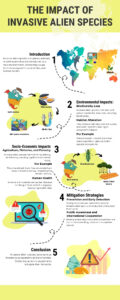Assess the National Clean Air Programme’s (NCAP) results. In what ways might Mission Life revitalize the NCAP to tackle the problem of air pollution? (Answer in 150 words) (Answer in 150 words)
The predicted scenario of an ice-free Arctic by 2040 could have significant impacts on oceans globally and specifically affect India in several ways:1. Global Oceanic Impact: - Sea Level Rise: Melting Arctic ice contributes to sea level rise globally. As sea ice melts, it doesn't directly raise seaRead more
- The predicted scenario of an ice-free Arctic by 2040 could have significant impacts on oceans globally and specifically affect India in several ways:1. Global Oceanic Impact:
– Sea Level Rise: Melting Arctic ice contributes to sea level rise globally. As sea ice melts, it doesn’t directly raise sea levels (since it displaces its own weight in water), but the loss of ice from Greenland and Arctic glaciers does contribute significantly.
– Altered Ocean Circulation:The Arctic plays a crucial role in global ocean circulation patterns, particularly through the thermohaline circulation (ocean conveyor belt). Changes in sea ice extent can disrupt this circulation, potentially affecting climate patterns worldwide.
– Habitat Loss: Arctic sea ice provides critical habitat for various species, including polar bears, seals, and Arctic seabirds. Melting ice threatens their habitats and food sources, leading to potential population declines.2. Specific Impact on India:
– Sea Level Rise:Coastal areas of India, particularly low-lying regions like the Sundarbans in West Bengal and parts of Gujarat and Kerala, are vulnerable to sea level rise. This could lead to increased coastal erosion, salinization of freshwater sources, and displacement of coastal communities.
– Monsoon Patterns: Changes in Arctic ice can influence atmospheric circulation patterns, potentially affecting the Indian monsoon. Variability in monsoon patterns could impact agriculture, water availability, and livelihoods across the country.
– International Relations: The opening up of Arctic sea routes due to reduced ice cover could present opportunities and challenges for India. It could potentially shorten shipping routes between Asia and Europe, affecting maritime trade and strategic interests.In conclusion, the melting of Arctic ice and the prospect of an ice-free Arctic by 2040 will have far-reaching consequences for oceanic conditions globally, including sea level rise and changes in ocean circulation. India, as a coastal nation and a country highly dependent on monsoonal rainfall, faces specific risks related to sea level rise, altered monsoon patterns, and potential geopolitical shifts due to changes in Arctic dynamics.



Ministry of Environment, Forest and Climate Change (MoEFCC) launched National Clean Air Programme (NCAP) in January, 2019 with an aim to improve air quality in 131 cities in 24 States and UTs by engaging all stakeholders. The programme envisages to achieve reductions up to 40% or achievement of NatiRead more
Ministry of Environment, Forest and Climate Change (MoEFCC) launched National Clean Air Programme (NCAP) in January, 2019 with an aim to improve air quality in 131 cities in 24 States and UTs by engaging all stakeholders. The programme envisages to achieve reductions up to 40% or achievement of National Ambient Air Quality Standards for Particulate Matter10 (PM 10) concentrations by 2025-26.
See lessMeasures taken by the government to improve air quality-
1. Reducing vehicular emissions by introducing schemes like Faster Adoption and Manufacturing of Electric vehicles, enhancing public transport by introducing metro rails connecting more cities.
2.Tightening emission norms for thermal power plants, installation of online continuous emission monitoring devices and ban on use of pet coke and furnace oil in NCR, and ban on use of pet coke in processes in cement plants, lime kilns and calcium carbide manufacturing units.
3.Public Grievances and Response System (PGRS) is developed under NCAP and Air quality monitoring cell has been constituted across the country in NCAP Cities.
Outcomes of the national Clean Air Programme-
A recent study conducted by the Climate Trends and Respirer Living Sciences reveals majority of the cities are far from the clean air targets of the NCAP.
◻ There seems to be a mixed progress among cities, while some of them like Varanasi ,Agra shows a decline others like Delhi reported marginal decline or sometimes even increased pollution loads.
◻ Lack of ambient Air Quality Monitoring systems in cities – Delhi and Mumbai have several such stations while others only have a hand full.
◻ The indo-gangetic plain remains highly vulnerable to elevated particulate matter concentrations (18 out of 20 most polluted cities).
◻ The varying results can be attributed to different factors like geographical locations, diverse emission sources and even meteorological factors.
Mission Lifestyle for Environment- the objective of this mission is to promote and encourage a sustainable and environmentally conscious way of living.
Mission Life can help to revitalize the NCAP in the following manner
1.Encourage people to use public transport systems in metro cities to avoid congestion and the resulting pollution due to individual vehicles.
2.Local bodies should persuade the residents to hand over the plastic waste instead of incinerating them and should heavily fine those who don’t comply.
3.Promotion and adoption of advanced Electric Vehicle technology especially in public transport systems through subsidies and benefits .
4.Systematically phasing out coal based thermal plants and giving way to Renewable energy generation.
5.Persuading manufacturers to produce more durable , recyclable plastic containers to ensure that they are not easily damaged and casted out as waste.
6. Spreading awareness among farmers about the environmental defects of stubble burning and suggest them viable alternative means.
Results suggest that the NCAP needs a makeover , region specific planning and Mission life with its pro planet people approach can help reinvigorate it.